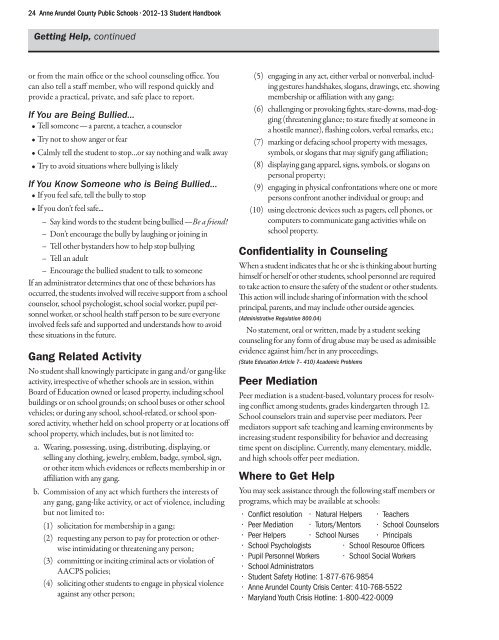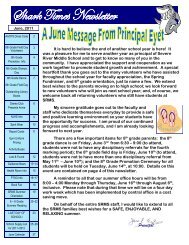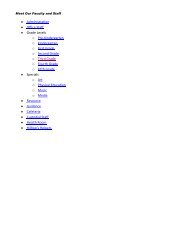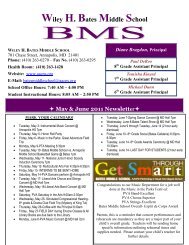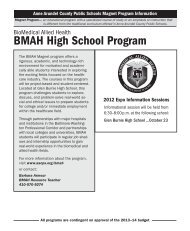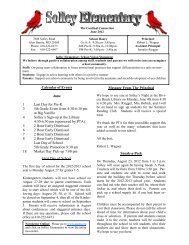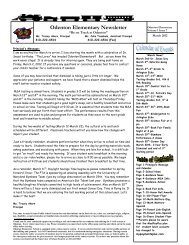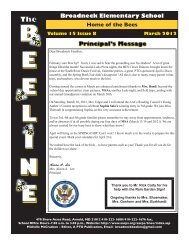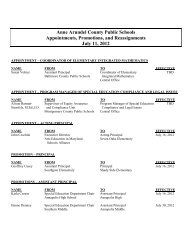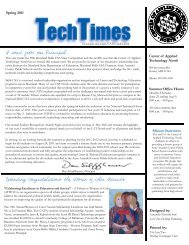Student Handbook - Anne Arundel County Public Schools
Student Handbook - Anne Arundel County Public Schools
Student Handbook - Anne Arundel County Public Schools
Create successful ePaper yourself
Turn your PDF publications into a flip-book with our unique Google optimized e-Paper software.
24 <strong>Anne</strong> <strong>Arundel</strong> <strong>County</strong> <strong>Public</strong> <strong>Schools</strong> • 2012–13 <strong>Student</strong> <strong>Handbook</strong><br />
Getting Help, continued<br />
or from the main office or the school counseling office. You<br />
can also tell a staff member, who will respond quickly and<br />
provide a practical, private, and safe place to report.<br />
If You are Being Bullied...<br />
• Tell someone — a parent, a teacher, a counselor<br />
• Try not to show anger or fear<br />
• Calmly tell the student to stop…or say nothing and walk away<br />
• Try to avoid situations where bullying is likely<br />
If You Know Someone who is Being Bullied...<br />
• If you feel safe, tell the bully to stop<br />
• If you don’t feel safe...<br />
– Say kind words to the student being bullied —Be a friend!<br />
– Don’t encourage the bully by laughing or joining in<br />
– Tell other bystanders how to help stop bullying<br />
– Tell an adult<br />
– Encourage the bullied student to talk to someone<br />
If an administrator determines that one of these behaviors has<br />
occurred, the students involved will receive support from a school<br />
counselor, school psychologist, school social worker, pupil personnel<br />
worker, or school health staff person to be sure everyone<br />
involved feels safe and supported and understands how to avoid<br />
these situations in the future.<br />
Gang Related Activity<br />
No student shall knowingly participate in gang and/or gang-like<br />
activity, irrespective of whether schools are in session, within<br />
Board of Education owned or leased property, including school<br />
buildings or on school grounds; on school buses or other school<br />
vehicles; or during any school, school-related, or school sponsored<br />
activity, whether held on school property or at locations off<br />
school property, which includes, but is not limited to:<br />
a. Wearing, possessing, using, distributing, displaying, or<br />
selling any clothing, jewelry, emblem, badge, symbol, sign,<br />
or other item which evidences or reflects membership in or<br />
affiliation with any gang.<br />
b. Commission of any act which furthers the interests of<br />
any gang, gang-like activity, or act of violence, including<br />
but not limited to:<br />
(1) solicitation for membership in a gang;<br />
(2) requesting any person to pay for protection or otherwise<br />
intimidating or threatening any person;<br />
(3) committing or inciting criminal acts or violation of<br />
AACPS policies;<br />
(4) soliciting other students to engage in physical violence<br />
against any other person;<br />
(5) engaging in any act, either verbal or nonverbal, including<br />
gestures handshakes, slogans, drawings, etc. showing<br />
membership or affiliation with any gang;<br />
(6) challenging or provoking fights, stare-downs, mad-dogging<br />
(threatening glance; to stare fixedly at someone in<br />
a hostile manner), flashing colors, verbal remarks, etc.;<br />
(7) marking or defacing school property with messages,<br />
symbols, or slogans that may signify gang affiliation;<br />
(8) displaying gang apparel, signs, symbols, or slogans on<br />
personal property;<br />
(9) engaging in physical confrontations where one or more<br />
persons confront another individual or group; and<br />
(10) using electronic devices such as pagers, cell phones, or<br />
computers to communicate gang activities while on<br />
school property.<br />
Confidentiality in Counseling<br />
When a student indicates that he or she is thinking about hurting<br />
himself or herself or other students, school personnel are required<br />
to take action to ensure the safety of the student or other students.<br />
This action will include sharing of information with the school<br />
principal, parents, and may include other outside agencies.<br />
(Administrative Regulation 800.04)<br />
No statement, oral or written, made by a student seeking<br />
counseling for any form of drug abuse may be used as admissible<br />
evidence against him/her in any proceedings.<br />
(State Education Article 7– 410) Academic Problems<br />
Peer Mediation<br />
Peer mediation is a student-based, voluntary process for resolving<br />
conflict among students, grades kindergarten through 12.<br />
School counselors train and supervise peer mediators. Peer<br />
mediators support safe teaching and learning environments by<br />
increasing student responsibility for behavior and decreasing<br />
time spent on discipline. Currently, many elementary, middle,<br />
and high schools offer peer mediation.<br />
Where to Get Help<br />
You may seek assistance through the following staff members or<br />
programs, which may be available at schools:<br />
• Conflict resolution<br />
• Peer Mediation<br />
• Peer Helpers<br />
• Natural Helpers<br />
• Tutors/Mentors<br />
• Teachers<br />
• School Counselors<br />
• School Nurses • Principals<br />
• School Psychologists • School Resource Officers<br />
• Pupil Personnel Workers • School Social Workers<br />
• School Administrators<br />
• <strong>Student</strong> Safety Hotline: 1-877-676-9854<br />
• <strong>Anne</strong> <strong>Arundel</strong> <strong>County</strong> Crisis Center: 410-768-5522<br />
• Maryland Youth Crisis Hotline: 1-800-422-0009


